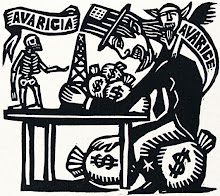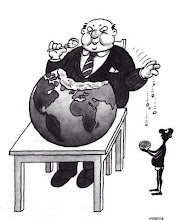Politics / Market Manipulation Jun 30, 2009 - 04:13 AM
By: Graham_Summers
Quietly and almost unnoticed by most Americans, the US Federal Government introduced a fourth branch to its political structure in 2006. As you know we already had three branches, they are:
The Judicial: the Supreme Court
The Executive: the President
The Legislative: Congress
This pretty much has us covered in terms of political strategy… but what about financial issues? Everyone knows Congress has no clue how to allocate capital. And the Executive Branch doesn’t exactly have a great track record when it comes to financial matters either (we’ve run a deficit virtually every year since 1970).
Shouldn’t we have a Financial Branch of government? A group of fiscal experts entirely devoted to keeping the US’s fiscal house in order?
Well, we actually do, but instead of installing a branch of smart, genuine financiers interested in benefiting the American people, we installed a bunch of greedy crooks intent on stealing as much of the public’s money as possible with no consequences what so ever.
Ladies and Gentleman, I present to you America’s Financial Branch of the Government: Goldman Sachs.
Trying to detail exactly how integrated Goldman has become to the Federal Government would be like trying to track the peanut butter swirls in Ben and Jerry’s Chocolate Peanut Butter Swirl ice cream. Indeed, with the exception of Ben Bernanke and a few other officials, Goldman Sachs provided all the lead characters for the Tragic Comedy that is our latest Financial Crisis.
Central to the entire mess is Hank “the Hammer” Paulson, our former Public Money Privatizer or Secretary of the Treasury as he is commonly known. To chronicle the full intricacy of Paulson’s web of cronies and the methods he used to funnel public funds to them and their business during the Crisis would require a book, not an essay.
However, one can draw a great deal of conclusions about Paulson’s central beliefs on business and politics by mentioning that one of his first positions of power was serving as assistant to John Erlichman, the central architect of Richard Nixon’s Watergate Scandal: a man who believed that when it came to wining seats of power, it’s best to break and enter, steal, and destroy one’s enemies at all costs.
Erlichman was convicted on conspiracy, obstruction of justice and perjury. Paulson went on to become CEO of Goldman Sachs.
Beyond Paulson, Goldman’s reach in this crisis is virtually unending. John Thain, former CEO of Merrill Lynch was a former Goldmanite. So was Robert Rubin, the Chairman of Citigroup. Then there’s Robert Steel, the head of Wachovia, Ed Liddy, who Paulson put in charge of the nationalized AIG, Mark Patterson, the current Treasury Chief of Staff, Neel Kashkari, the guy in charge of allocating TARP funds…
heck, even Tim Geithner was mentored by the afore-mentioned Robert Rubin.
What’s staggering is that no one seems outraged by all of this. It’s not too difficult to connect the dots on what happened: a former Goldman exec was put in charge of allocating public funds to other former Goldman execs who in turn allocated the funds to their employees in the form of bonuses and enormous salaries. Indeed, it’s telling that Paulson’s original proposal for the $800 billion bailout entailed NO curtailing or oversight of executive compensation at the firm’s receiving our money.
I’m starting to run out of room here. But if you’re interested in these issues and learning more about Goldman Sach’s involvement in our Federal Government, I STRONGLY urge you to read Matt Taibbi’s recent expose on the firm in Rolling Stone magazine. Be forewarned, you will be infuriated by what Taibbi reveals. But if it gets people contacting their local representatives and Senators asking why we haven’t launched any investigations into Paulson’s allocation of public funds.
You can see Taibbi’s article online at: http://zerohedge.blogspot.com/2009/06/goldman-sachs-engineering-every-major.html
I’ve put together a FREE special report detailing how to play the coming agriculture boom as well as other inflation hedges that can protect you portfolio from the Fed’s money printing. You can pick up a FREE copy at: www.gainspainscapital.com.
Good Investing!
Graham Summers
http://gainspainscapital.com
PS. I’ve put together a FREE special report detailing how to play the coming agriculture boom as well as other inflation hedges that can protect you portfolio from the Fed’s money printing. You can pick up a FREE copy at: www.gainspainscapital.com.
Graham Summers: Graham is Senior Market Strategist at OmniSans Research. He is co-editor of Gain, Pains, and Capital, OmniSans Research’s FREE daily e-letter covering the equity, commodity, currency, and real estate markets.
Graham also writes Private Wealth Advisory, a monthly investment advisory focusing on the most lucrative investment opportunities the financial markets have to offer. Graham understands the big picture from both a macro-economic and capital in/outflow perspective. He translates his understanding into finding trends and undervalued investment opportunities months before the markets catch on: the Private Wealth Advisory portfolio has outperformed the S&P 500 three of the last five years, including a 7% return in 2008 vs. a 37% loss for the S&P 500.
Previously, Graham worked as a Senior Financial Analyst covering global markets for several investment firms in the Mid-Atlantic region. He’s lived and performed research in Europe, Asia, the Middle East, and the United States.
© 2009 Copyright Graham Summers - All Rights Reserved
Disclaimer: The above is a matter of opinion provided for general information purposes only and is not intended as investment advice. Information and analysis above are derived from sources and utilising methods believed to be reliable, but we cannot accept responsibility for any losses you may incur as a result of this analysis. Individuals should consult with their personal financial advisors.
Graham Summers Archive
http://www.marketoracle.co.uk/Article11686.html
Wednesday, July 1, 2009
Subscribe to:
Post Comments (Atom)














No comments:
Post a Comment